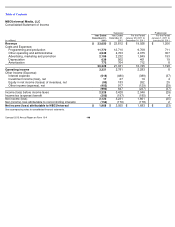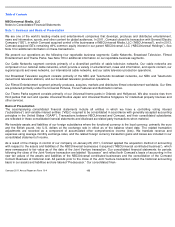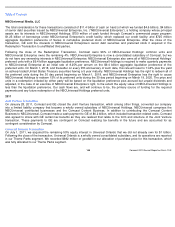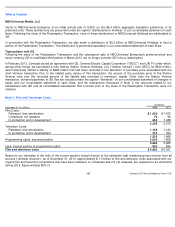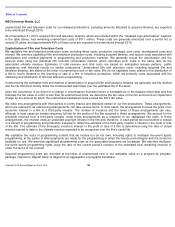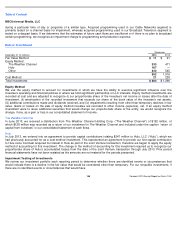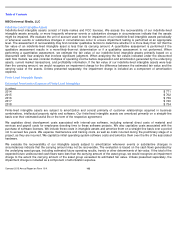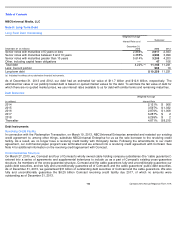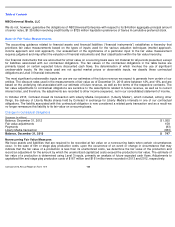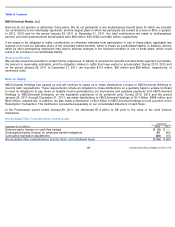Comcast 2013 Annual Report Download - page 163
Download and view the complete annual report
Please find page 163 of the 2013 Comcast annual report below. You can navigate through the pages in the report by either clicking on the pages listed below, or by using the keyword search tool below to find specific information within the annual report.
Table of Contents
NBCUniversal Media, LLC
unamortized film and television costs for our released productions, excluding amounts allocated to acquired libraries, are expected
to be amortized through 2016.
As of December 31, 2013, acquired film and television libraries, which are included within the “released, less amortization”
captions
in the table above, had remaining unamortized costs of $711 million. These costs are generally amortized over a period not to
exceed 20 years, and approximately 49% of these costs are expected to be amortized through 2016.
Capitalization of Film and Television Costs
We capitalize film and television production costs, including direct costs, production overhead, print costs, development costs and
interest. We amortize capitalized film and television production costs, including acquired libraries, and accrue costs associated with
participation and residual payments to programming and production expense. We generally record the amortization and the
accrued costs using the individual film forecast computation method, which amortizes such costs in the same ratio as the
associated ultimate revenue. Estimates of total revenue and total costs are based on anticipated release patterns, public
acceptance and historical results for similar productions. Unamortized film and television costs, including acquired film and
television libraries, are stated at the lower of unamortized cost or fair value. We do not capitalize costs related to the distribution of
a film to movie theaters or the licensing or sale of a film or television production, which are primarily costs associated with the
marketing and distribution of film and television programming.
In determining the estimated lives and method of amortization of acquired film and television libraries, we generally use the method
and the life that most closely follow the undiscounted cash flows over the estimated life of the asset.
Upon the occurrence of an event or a change in circumstance that was known or knowable as of the balance sheet date and that
indicates the fair value of a film is less than its unamortized costs, we determine the fair value of the film and record an impairment
charge for the amount by which the unamortized capitalized costs exceed the film’s fair value.
We enter into arrangements with third parties to jointly finance and distribute certain of our film productions. These arrangements,
which are referred to as cofinancing arrangements, can take various forms. In most cases, the arrangement involves the grant of an
economic interest in a film to a third-
party investor. The number of investors and the terms of these arrangements can vary,
although in most cases an investor assumes full risk for the portion of the film acquired in these arrangements. We account for the
proceeds received from a third-
party investor under these arrangements as a reduction to our capitalized film costs. In these
arrangements, the investor owns an undivided copyright interest in the film and, therefore, in each period we record either a charge
or a benefit to programming and production expense to reflect the estimate of the third-party investor’
s interest in the profit or loss
of the film. The estimate of the third-party investor’
s interest in the profit or loss of a film is determined using the ratio of actual
revenue earned to date to the ultimate revenue expected to be recognized over the film’s useful life.
We capitalize the costs of programming content that we license but do not own, including rights to multiyear live-
event sports
programming, at the earlier of when payments are made for the programming or when the license period begins and the content is
available for use. We amortize capitalized programming costs as the associated programs are broadcast. We amortize multiyear,
live-event sports programming rights using the ratio of the current period’
s revenue to the estimated total remaining revenue or
under the terms of the contract.
Acquired programming costs are recorded at the lower of unamortized cost or net realizable value on a program by program,
package, channel or daypart basis. A daypart is an aggregation of programs broadcast
Comcast 2013 Annual Report on Form 10-K
158


